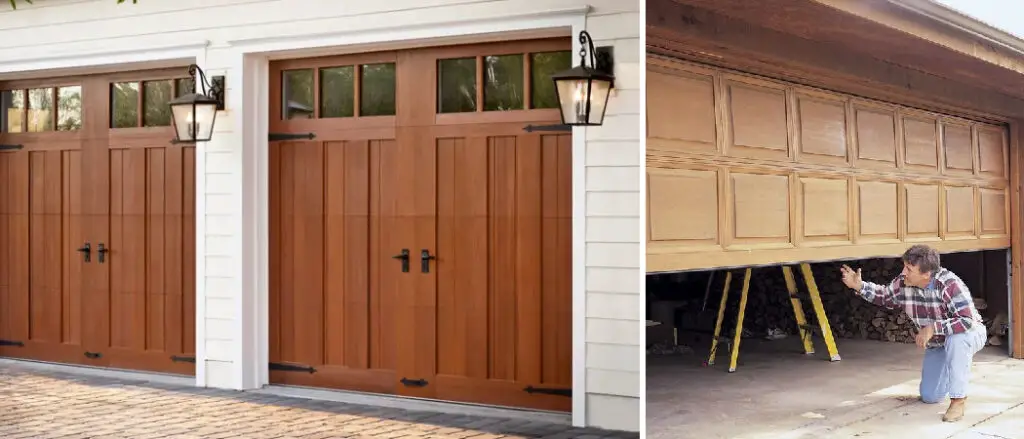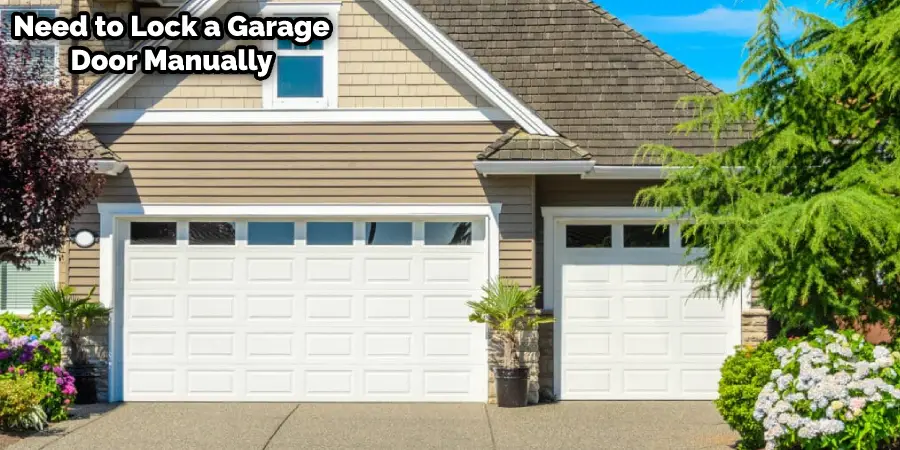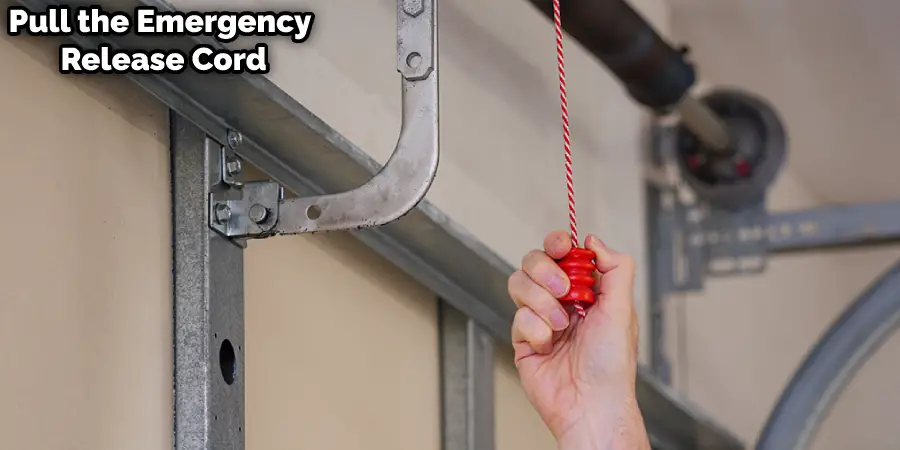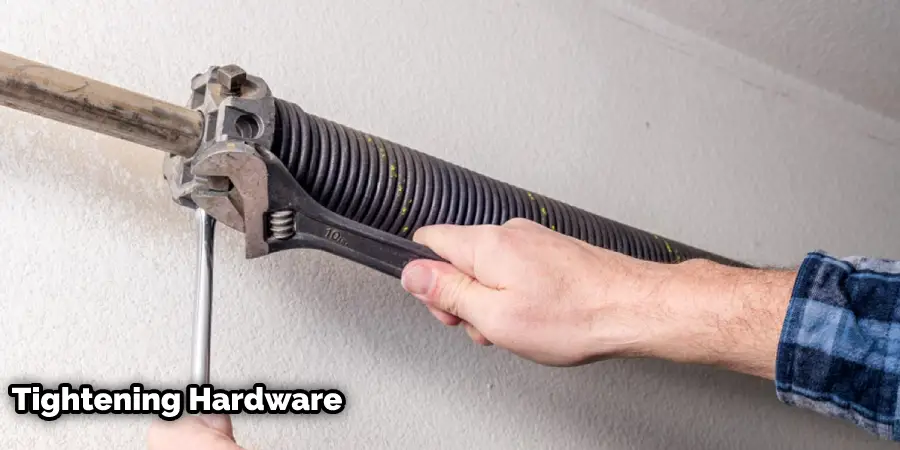Do you need to lock your garage door manually for some reason? While it’s possible to do so, many homeowners are unaware of how to properly lock a manual garage door without the assistance of an automated system or electronic device.

Thankfully, we’ve put together this comprehensive guide that covers everything from why you might want to lock your garage door manually in the first place down through all the steps needed for correctly accomplishing just that. Keep reading to learn more knowledge about how to lock a garage door manually.
Why You Might Need to Lock a Garage Door Manually
There are several situations where manually locking a garage door becomes necessary. Here are some common scenarios:
- Power Outages: During a power outage, automatic garage door openers may not function, leaving the door in an unlocked or partially open position. Manually locking the garage door ensures that it remains securely closed and prevents unauthorized access.
- Malfunctioning Automatic Opener: If the automatic garage door opener malfunctions or experiences technical issues, relying on the manual locking mechanism becomes essential. It allows you to secure the garage until the opener is repaired or replaced.
- Security Purposes: Manual locking can serve as an additional layer of security, even when the automatic opener is functioning correctly. It provides peace of mind by ensuring that the door is firmly locked and resistant to forced entry attempts.
- Extended Absence: When leaving your property unattended for an extended period, such as during vacations or business trips, manually locking the garage door adds an extra level of security. It reduces the risk of burglaries or break-ins by making it more difficult for intruders to gain access.
- Maintenance or Repair Work: During maintenance or repair tasks on the garage door or opener, it is advisable to disable the automatic operation and manually lock the door. This prevents accidental activation of the door while work is being carried out, ensuring the safety of individuals involved in the process.
- Enhanced Security Measures: Some individuals prefer to manually lock their garage doors regularly as part of their security routine. By relying on manual locks, they have more control over the security of their garage and can ensure it is properly secured at all times.
- Emergency Situations: In emergency situations such as severe weather events or natural disasters, where power loss or damage to the garage door opener may occur, manually locking the door provides immediate protection and prevents potential hazards.

Remember, manual locking should be done in conjunction with other security measures such as installing sturdy doors, reinforcing locks, and implementing a comprehensive security system for optimal protection.
Understand Garage Door Types
Garage doors are an essential feature of many homes and businesses today. However, with so many types of garage doors available, it can be challenging to understand which one is right for your property. Roll-up doors are an excellent choice for those who need to save space, as they take up minimal room when opening and closing.
Sectional doors, on the other hand, are incredibly popular due to their versatility and style. If you’re looking for a more traditional option, side-hinged doors may be the ideal option for you. Finally, up-and-over doors are a great solution for those who want a garage door that is easy to operate but still provides ample security.
Understanding the different types of garage doors and their benefits can help you make an informed decision when it comes to selecting the right one for your property. So, consider your requirement and choose the right garage door wisely.
8 Methods on How to Lock a Garage Door Manually
1. Pull the Emergency Release Cord:
If your garage door has an emergency release cord, you can pull it to disengage the automatic opener and manually lock the door. This is a simple process that only takes a few seconds.

2. Utilize the Lock Handle:
Most manual garage doors have a handle near the top of the door which locks and unlocks the door. All you need to do is turn the handle until it locks into place.
3. Secure the Door With a Padlock:
If your garage door has a locking mechanism, such as an eyelet or handle, you can use a padlock for additional security. This is especially useful if you are away from your property for an extended period of time.
4. Install a Deadbolt Lock:
Installing a deadbolt lock is one of the most secure methods of locking a manual garage door. This requires some additional hardware and installation, but it provides superior protection over other options.
5. Install a Vertical Rod Lock:
One of the most popular methods of manually locking a garage door is by installing a vertical rod lock. This consists of a bar that slides into place across the tracks when locked, preventing the door from being opened.
6. Install an Automatic Lock:
For those who want to make their garage even more secure, an automatic locking system is the way to go. These systems feature sensors that detect when the door is opened and locked, providing even more peace of mind.
7. Install a Slide Lock:
Slide locks are another great option for manually locking a garage door. They are much simpler than vertical rod locks, and they can be installed quickly and easily.
8. Use a Bicycle Lock:
For those looking for an inexpensive yet effective way to lock their garage door, a bicycle lock is the perfect solution. Simply loop the chain around the track of your garage door and secure it with the padlock, providing additional protection against potential intruders.
By understanding the different ways to lock a manual garage door, you can choose the best option for your property and ensure that it remains safe from potential hazards. Be sure to take into account all of your needs when deciding on the most suitable locking method. With the right security measures in place, you can rest assured that your garage is safe and secure.
Maintenance and Regular Care of The Manual Locking Components of Your Garage Door
Maintenance and regular care of the manual locking components of your garage door are essential for their proper functionality and longevity. Here are some tips and best practices to follow:
1.Lubrication:
Apply lubrication to the moving parts of the manual locking mechanism, such as hinges, locks, slide bolts, or T-handle mechanisms. This helps reduce friction, ensures smooth operation, and prevents components from seizing or getting stuck. Use a lubricant recommended by the manufacturer, such as silicone-based or white lithium grease, and avoid using WD-40 or other penetrating oils.
2. Cleaning:
Periodically clean the manual locking components to remove dirt, debris, or grime that may hinder their performance. Use a soft cloth or brush to wipe away any buildup and ensure that the locks, bolts, or handles are free from obstructions.
3. Tightening Hardware:
Regularly inspect and tighten the hardware associated with the manual locking mechanism, including screws, bolts, or fasteners. Over time, vibrations and use can cause them to loosen, potentially compromising the security of the door. Use the appropriate tools to tighten any loose hardware and ensure they are secure.

4. Testing the Manual Locking Mechanism:
It is important to periodically test the manual locking mechanism to verify its proper functioning. Follow these steps:
- Close the garage door and engage the automatic opener if applicable.
- Disable the automatic opener by unplugging it or turning off the power source.
- Attempt to open the door manually while it is in the locked position to ensure that the manual locking components are secure and functional.
- Test the unlocking and locking process to confirm that the mechanism operates smoothly without any obstructions or difficulties.
5. Professional Inspection and Maintenance:
Consider scheduling regular professional inspections and maintenance for your garage door, including its manual locking components. Garage door specialists can identify any potential issues, perform adjustments or repairs, and provide expert advice on maintaining optimal security.
By following these maintenance tips and periodically testing the manual locking mechanism, you can ensure that your garage door remains secure and functions properly when needed. Regular care and attention will extend the lifespan of the manual locking components and contribute to overall garage security.
Troubleshooting Tips
When manually locking a garage door, you may encounter some common issues that can hinder the proper functioning of the locking mechanism. Here are troubleshooting tips and practical solutions for addressing these problems:
1. Jammed Locks:
If your manual locks are jammed, check to see if the slide bolt is stuck in the open or closed position. If it is stuck, use a lubricant and work it back and forth several times until it moves freely again. Also, inspect the locking mechanism for any obstructions that may be preventing its proper operation.
2. Misaligned Tracks:
If the locking tracks are misaligned, you may experience difficulty when manually locking your garage door. To resolve this issue, inspect the tracks and adjust them as needed until they are properly aligned with one another.
3. Malfunctioning Locking Mechanism:
If your manual locking mechanism is malfunctioning, you should contact a professional garage door technician. They can inspect the system and repair or replace any components that have become damaged or worn over time.
4.Key or Lock Malfunctions:
If the key or lock is not functioning properly, you may need to replace it. Contact a locksmith for assistance with this issue and make sure to provide them with any necessary information about the type of lock used on your garage door.
5.Binding or Sticking Mechanism:
If the manual locking mechanism is binding or sticking, you should check to make sure that all of the hardware is properly tightened. You can also use a lubricant such as WD-40 to help loosen any stuck components and reduce friction.
By following these tips, you should be able to quickly troubleshoot and resolve any issues that arise when manually locking your garage door. If the problem persists, contact a professional for assistance. They can inspect the system and make any necessary adjustments or repairs to ensure optimal security.
Concluison
Securing your garage door manually is a vital skill that ensures the safety of your belongings and enhances the overall security of your property. By following the step-by-step guide and incorporating best practices, you can confidently protect your garage against unauthorized access and potential threats.
Remember, regular maintenance, awareness of your garage door’s condition, and investing in additional security measures are all key elements of maintaining a secure garage. Thanks for reading this article about how to lock a garage door manually.
